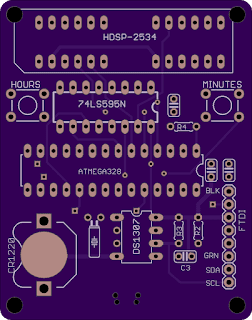As mentioned previously, the font must be provided too (content of file "font5x5.h" shown below):
#ifndef _FONT5X5_H_
#define _FONT5X5_H_
// ascii characters 0x41-0x7a (32-127);
static unsigned char font5x5[] =
{
0x00, 0x20, 0x40, 0x60, 0x80, // space
0x04, 0x24, 0x44, 0x60, 0x84, // !
0x0A, 0x2A, 0x40, 0x60, 0x80, // "
0x0A, 0x3F, 0x4A, 0x7F, 0x8A, // #
0x0F, 0x34, 0x4E, 0x65, 0x9E, // $
0x19, 0x3A, 0x44, 0x6B, 0x93, // %
0x08, 0x34, 0x4D, 0x72, 0x8D, // &
0x04, 0x24, 0x40, 0x60, 0x80, // '
0x02, 0x24, 0x44, 0x64, 0x82, // (
0x08, 0x24, 0x44, 0x64, 0x88, // )
0x15, 0x2E, 0x5F, 0x6E, 0x95, // *
0x04, 0x24, 0x5F, 0x64, 0x84, // +
0x00, 0x20, 0x40, 0x64, 0x84, // ,
0x00, 0x20, 0x4E, 0x60, 0x80, // -
0x00, 0x20, 0x40, 0x60, 0x84, // .
0x01, 0x22, 0x44, 0x68, 0x90, // /
0x0E, 0x33, 0x55, 0x79, 0x8E, // 0
0x04, 0x2C, 0x44, 0x64, 0x8E, // 1
0x1E, 0x21, 0x46, 0x68, 0x9F, // 2
0x1E, 0x21, 0x4E, 0x61, 0x9E, // 3
0x06, 0x2A, 0x5F, 0x62, 0x82, // 4
0x1F, 0x30, 0x5E, 0x61, 0x9E, // 5
0x06, 0x28, 0x5E, 0x71, 0x8E, // 6
0x1F, 0x22, 0x44, 0x68, 0x88, // 7
0x0E, 0x31, 0x4E, 0x71, 0x8E, // 8
0x0E, 0x31, 0x4F, 0x62, 0x8C, // 9
0x00, 0x24, 0x40, 0x64, 0x80, // :
0x00, 0x24, 0x40, 0x6C, 0x80, // ;
0x02, 0x24, 0x48, 0x64, 0x82, // <
0x00, 0x3F, 0x40, 0x7F, 0x80, // =
0x08, 0x24, 0x42, 0x64, 0x88, // >
0x0E, 0x31, 0x42, 0x64, 0x84, // ?
0x0E, 0x35, 0x57, 0x70, 0x8E, // @
0x04, 0x2A, 0x5F, 0x71, 0x91, // A
0x1E, 0x29, 0x4E, 0x69, 0x9E, // B
0x0F, 0x30, 0x50, 0x70, 0x8F, // C
0x1E, 0x29, 0x49, 0x69, 0x9E, // D
0x1F, 0x30, 0x5E, 0x70, 0x9F, // E
0x1F, 0x30, 0x5E, 0x70, 0x90, // F
0x0F, 0x30, 0x53, 0x71, 0x8F, // G
0x11, 0x31, 0x5F, 0x71, 0x91, // H
0x0E, 0x24, 0x44, 0x64, 0x8E, // I
0x01, 0x21, 0x41, 0x71, 0x8E, // J
0x13, 0x34, 0x58, 0x74, 0x93, // K
0x10, 0x30, 0x50, 0x70, 0x9F, // L
0x11, 0x3B, 0x55, 0x71, 0x91, // M
0x11, 0x39, 0x55, 0x73, 0x91, // N
0x0E, 0x31, 0x51, 0x71, 0x8E, // O
0x1E, 0x31, 0x5E, 0x70, 0x90, // P
0x0C, 0x32, 0x56, 0x72, 0x8D, // Q
0x1E, 0x31, 0x5E, 0x74, 0x92, // R
0x0F, 0x30, 0x4E, 0x61, 0x9E, // S
0x1F, 0x24, 0x44, 0x64, 0x84, // T
0x11, 0x31, 0x51, 0x71, 0x8E, // U
0x11, 0x31, 0x51, 0x6A, 0x84, // V
0x11, 0x31, 0x55, 0x7B, 0x91, // W
0x11, 0x2A, 0x44, 0x6A, 0x91, // X
0x11, 0x2A, 0x44, 0x64, 0x84, // Y
0x1F, 0x22, 0x44, 0x68, 0x9F, // Z
0x07, 0x24, 0x44, 0x64, 0x87, // [
0x10, 0x28, 0x44, 0x62, 0x81, // \
0x1C, 0x24, 0x44, 0x64, 0x9C, // ]
0x04, 0x2A, 0x51, 0x60, 0x80, // ^
0x00, 0x20, 0x40, 0x60, 0x9F, // _
0x0A, 0x2A, 0x40, 0x60, 0x80, // '
0x00, 0x2E, 0x52, 0x72, 0x8D, // a
0x10, 0x30, 0x5E, 0x71, 0x9E, // b
0x00, 0x2F, 0x50, 0x70, 0x8F, // c
0x01, 0x21, 0x4F, 0x71, 0x8F, // d
0x00, 0x2E, 0x5F, 0x70, 0x8E, // e
0x04, 0x2A, 0x48, 0x7C, 0x88, // f
0x00, 0x2F, 0x50, 0x73, 0x8F, // g
0x10, 0x30, 0x56, 0x79, 0x91, // h
0x04, 0x20, 0x4C, 0x64, 0x8E, // i
0x00, 0x26, 0x42, 0x72, 0x8C, // j
0x10, 0x30, 0x56, 0x78, 0x96, // k
0x0C, 0x24, 0x44, 0x64, 0x8E, // l
0x00, 0x2A, 0x55, 0x71, 0x91, // m
0x00, 0x36, 0x59, 0x71, 0x91, // n
0x00, 0x2E, 0x51, 0x71, 0x8E, // o
0x00, 0x3E, 0x51, 0x7E, 0x90, // p
0x00, 0x2F, 0x51, 0x6F, 0x81, // q
0x00, 0x33, 0x54, 0x78, 0x90, // r
0x00, 0x23, 0x44, 0x62, 0x8C, // s
0x08, 0x3C, 0x48, 0x6A, 0x84, // t
0x00, 0x32, 0x52, 0x72, 0x8D, // u
0x00, 0x31, 0x51, 0x6A, 0x84, // v
0x00, 0x31, 0x55, 0x7B, 0x91, // w
0x00, 0x32, 0x4C, 0x6C, 0x92, // x
0x00, 0x31, 0x4A, 0x64, 0x98, // y
0x00, 0x3E, 0x44, 0x68, 0x9E, // z
0x06, 0x24, 0x48, 0x64, 0x86, // {
0x04, 0x24, 0x44, 0x64, 0x84, // |
0x0C, 0x24, 0x42, 0x64, 0x8C, // }
0x00, 0x27, 0x5C, 0x60, 0x80, // ~
};
#endif // _FONT5X5_H_
1. add the following line at the top:
2. replace the function writeDisplay() written for HDSP-2534, with the following:
Hardware-wise, some re-wiring is required on the HDSP board, starting with the removal of the 595 shift register. Then, D3, D4 and D5 (ATmega328 pins 5, 6, 11) must be connected respectively to SDCLK, LOAD and DATA pins (1, 2, 27) of the SCD5583 display.
It is worth mentioning that the measured current drawn was between 10mA (lowest brightness) and 20mA (highest), and that it works similarly well when powered by 3V3.




